Pastries are flying off the supermarket shelves as retailers look to entice consumers with on-trend, indulgent in-store bakery (ISB) options.
Want proof? The ISB category (excluding cake) has grown 5.4% in value year on year to reach £1.5bn, according to Kantar data for the 52 weeks to 1 September 2024, with revenue split almost equally between sweet and savoury lines. Sales of sweet ISB lines are up 3.2% accounting for £746m of sales. It’s not all inflation driven either – pack sales are also up 2.5%.
When breaking down the sweet side of ISB further, it’s clear that the star performers of late are in the pastry category – Danish pastries have leapt 15% year on year with value sales of £134m, and viennoiserie is up to £466m representing an 8% improvement on 12 months ago.
Supermarkets remain the most common place for pastry purchases, with recent UK consumer research from bakery supplier Délifrance finding that 47% of shoppers head to an ISB counter or aisle for their fresh ‘n’ flaky fix. Thirty-four percent head to an independent or chain bakery and 30% choose to purchase their pastries via a café or coffee shop.
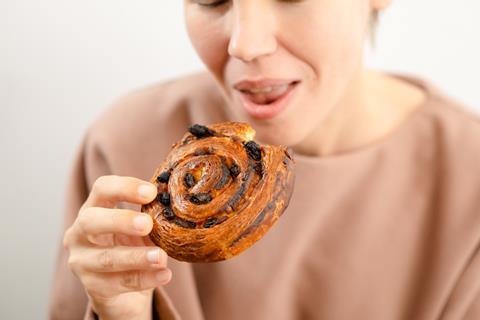
So how are retailers keeping up pace with the popularity of pastries, what are the emerging trends, and what innovations have been baked up over the past year?
“The biggest change to ISB Danish pastry ranges has been the introduction of premium tiering, driven by consumer demand for quality, value-driven sweet bakery items that look artisan and fulfil the impulse-driven ‘treat’ mission,” explains Samantha Winsor, Lantmännen Unibake UK marketing manager. “Retailers are targeting a younger audience by taking inspiration from high-street trends, stocking dessert-inspired flavoured pastries that are visually impactful and showcase pieces of fruit.”
M&S is a prime example of a retailer hitting all of these marks of late – simply look at its 2023 Christmas range for proof. It featured a Cherry Stollen Croissant sprinkled with almonds, a Roasted Hazelnut Chocolatine (which has since been listed for New Bakery Product of the Year at the 2024 Baking Industry Awards), an Apricot & Madagascan Vanilla Croissant, and Raspberry & Madagascan Vanilla Teardrop finished in store with raspberries.
It’s a similar story in other retailers as well. Hannah Forster, Asda’s junior product developer for hot cross, fruited, and ISB pastry, explains the retailer’s customer base is “driven by routine and pastries are part of their daily/weekly habit”. These customers are “a bit more adventurous and are more likely to take risks” which means the Asda ISB pastry range has developed to ensure “a balance of core affordable lines with pockets of innovation,” Forster comments.
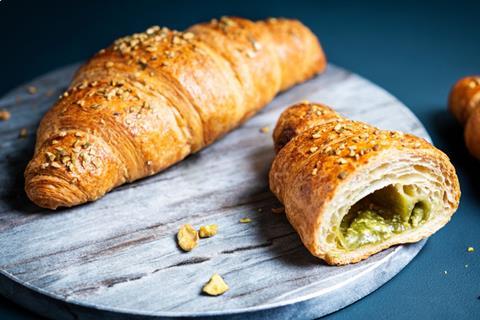
Think plain croissants for the day-to-day and something slightly more special for the weekend. The special something could be the Extra Special Triple Pain Au Choc (priced at £2 for a two-pack) which is filled with white chocolate pastry cream with white, milk, and dark chocolate chips inside and chocolate nibs on top. The Pistachio-filled Croissant is also a contender having been added to Asda’s 10-strong line-up of croissants this year which collectively shifts over 100,000 units per week.
It follows a significant revamp of Asda’s ISB operation, which has seen it move away from scratch baking to an ambient bakery model with pre-baked products delivered to stores from a centralised bakery each day. Since then, Asda has invested in the innovation and quality of its ISB lines which has resulted in some being removed from the online offering to maintain quality standards as they were deemed ‘best same day’.
Pastry guest stars
Operating models and market dynamics do have a part to play in the ISB pastry story. An undeniable success story in ISB over the past year is Lidl, which followed up its 2023 Bakery Retailer of the Year triumph by overtaking Tesco for the largest share of the ISB market.
Pastries form a key part of Lidl’s ISB strategy – among the discounter’s core bakery lines are Pastel de Nata and the bestselling All Butter Croissant, which shifted an average of 122 units every minute across its UK estate according to sales data for the first quarter of 2024.
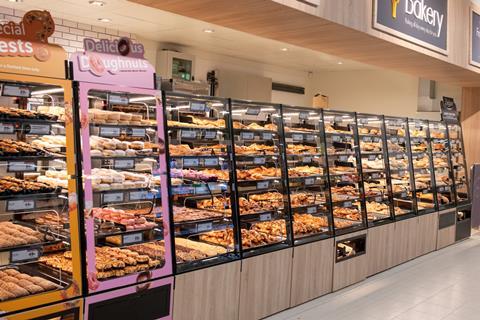
A core part of Lidl’s recent investment in bakery is its introduction of the Special Guest bays which see two new products added every fortnight and remain on shelves for four weeks. These, according to Holly Bleach, head of buying at Lidl, act as an “amazing playground to test new innovations”. Although not exclusively pastry lines, the impulse nature of flaky bakes mean they play well in the Special Guests space with innovations such as the Pizza Twist, Blackforest Crown, Raspberry Croissant, and Gingerbread Plait among the limited-edition pastries up for grabs.
The discounter is also drawing consumers to its bakery aisles with discounts and deals through its Lidl Plus app, with a recent deal offering free croissants to 50,000 football fans who put the code ‘football’ in their app during the FIFA World Cup.
While Tesco may have been pipped at the market post by Lidl, it has led the charge on trying to bring ISB capabilities, and thus freshly baked pastries, to even the smallest of its stores. A trial of Tesco’s new ‘bake on the shop floor’ model at its Twickenham Express outlet was unveiled in May, incorporating an oven, cooling rack, loose product display cassettes, and packed product shelving in just over one square metre of shop floor space.
More and moreish
Initiatives such as these are definitely helping to lure more consumers in – they are also luring them back more frequently.
Délifrance research discovered that almost double the number of consumers (42%) were now enjoying pastries multiple times a week compared to less than a quarter (24%) in 2019.
Pastries have become an ‘everyday choice’ for many consumers, notes Délifrance marketing director Stéphanie Brillouet, adding that they are increasing seen as an “affordable treat”. The manufacturer embraced this as part of the development for its Extra-Ordinary viennoiserie range utilises a long fermentation process more commonly applied in bread-making to help develop flavours and yield a “premium result with unique layering”. These products are pitched at the consumers who prefer to indulge in a pastry alone, or a ‘me’ moment as Brillouet puts it.
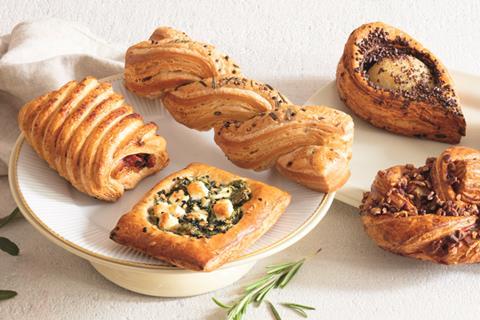
Core viennoiserie means croissants and pains au chocolat, which have long been staples for breakfast. However, Erwan Inizan, the Northern Europe sales director at bakery supplier Bridor, believes there has been a considerable rise in their popularity because they also cater to the grab-and-go lifestyle that today’s consumers value. “Furthermore, supermarket bakeries are becoming increasingly popular choices for snacking occasions too,” he adds.
This is something The Co-op tapped into earlier this year when it made some of its ISB lines including croissants, cinnamon swirls, and almond Danishes available as snack options for its meal deals.
New formats for classic recipes
Opening up new eating occasions for existing pastries is just one of the tactics being utilised – drawing consumers in with exciting new products is another.
“The trend for dessert-inspired nostalgic flavours isn’t dissipating,” explains Lantmännen’s Winsor. “While still popular with the older generation, it is targeting and bringing in the younger shoppers.”
This is reflected in Lantmännen Unibake’s new Signature Fruit Danish range for the out of home and the wholesale market, which features flavours of cherry & almond, apple & cinnamon, and rhubarb vanilla custard & meringue.
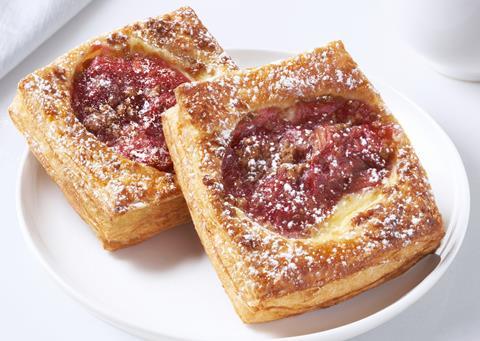
Asda has sought to bring in consumers of all ages with the likes of a Trifle Crown, complete with raspberry and custard filling, topped with almonds and a glaze, and latest new product Tiramisu Danish which is finished in store with a dusting of cocoa powder. Other NPD rolled out at retailers include the Tesco Finest Strawberries & Clotted Cream Danish, which became a top seller following its spring launch. Waitrose has also got in on the nostalgia trend with a tiramisu bun and apple tarte tatin turnover among new pastries rolled out at its bakery counters earlier this month.
New pastry flavours can change with the seasons. “In the summer, consumers are expecting more summer berries, tropical fruit and citrus-flavoured desserts, whereas the winter sees flavour inspiration turn to classic puddings such as traditional fruit pies and crumbles, warming spiced notes of ginger or cinnamon weaved in,” Winsor adds.
Tantalise all the senses
Flavour is undoubtedly a driver of pastry purchases but it’s important not to forget the other senses – particularly in a category which is largely impulse driven.
“The visual element of food is also a key trend that we are innovating around as we know that our customers enjoy having access to baked goods that not only taste delicious but look spectacular too,” says Inizan at Bridor. “This is understandable in a world where social media dominates and serving high-quality products encourages consumers to capture the moment and share it on their social channels, ultimately helping to drive footfall to our customer’s outlets.”
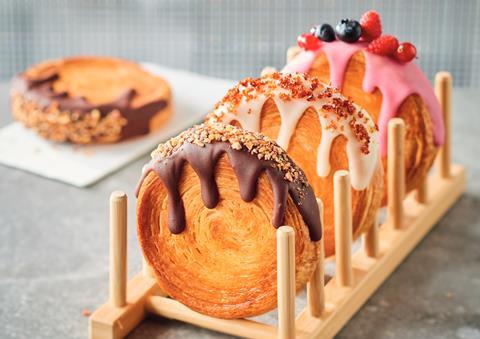
Anthony Saison, head of category insights & customer marketing at Moi by Mademoiselle Desserts highlights the role of colour in this as retailers have started to grab the attention of shoppers and spur impulse buys through tactics such as adding visual pieces of vibrant fruit. “The ISB category is developing from a sea of beige to a fresher, more colourful offering,” he says.
There’s a third sensorial factor to consider as well – texture. Research by Puratos found that 72% of people claim to be seeking out foods with diverse textures.
“Bakery is well placed to capitalise on this, with the combination of light, flaky pastry texture with soft, gooey fillings offering consumers a delicious mix of flavours and textures to treat their senses,” notes Winsor from Lantmännen’s.
‘Hyped-up hybrids’
Speaking of mixing things up, it’s been more than a decade since the cronut was unleashed, kicking off the hybrid craze leading to further portmanteaus like the cruffin and the crookie. While these have gone down a storm on the social media accounts of many an artisanal baker, Délifrance’s Brillouet claims they are still “a long way from making the mainstream” and becoming a regular on the line-up at supermarket in-store bakeries.
“From our research we know that over a third (38%) of pastry consumers haven’t seen or heard of any hybrid pastries, and almost a quarter are not interested in trying them,” Brillouet reveals. “So, it’s important that we keep the hyped-up hybrids’ true impact in perspective.”

The same goes for the likes of giant croissants, cube croissants, and more which have been causing a stir on social media over the past few years. While artisan bakers can invest time and skills in them and charge a suitably high price point to reflect this, in-store bakeries don’t always have that luxury.
“Such trends have driven more NPD in the pastry market, but the complexity of such shapes are hard to produce in the store bakeries,” explains Forster from Asda. They’re not entirely off the table though as she admits the retailer is “constantly driving new capabilities” across its estate and closely monitor social media trends to meet consumer needs for new and exciting concepts.
The myriad of pastry innovations over the past year means that retailer ISB have never been in better shape to cater to evolving demands from consumers and help them maintain their love affair with pastries for breakfast and beyond.
ADVERTISEMENT: LANTMÄNNEN UNIBAKE UK

Lantmännen Unibake UK is part of the Lantmännen Unibake group which operates 37 bakeries around the world and forms part of Lantmännen’s food business sector.
The company continues to invest in quality and innovation in line with dynamic market trends in the bakery industry. Lantmännen Unibake UK recently entered the Speciality Bread market by adding a new state-of-the-art line to its Milton Keynes bakery. Following extensive research into Sweet Pastry, investments were made into chunky fruit-filling depositors for the bakery to enhance our capability, allowing us to innovate by creating pastries with visible pieces of fruit and develop the market opportunity within the premium Danish Pastry segment. Staying ahead of changing consumer preferences, shopping habits and trends is vital for capitalising on market opportunities.
Sweet ISB is on an upward trajectory, with a year-on-year uplift in sales value of 3.2%[1] and Danish Pastry accounting for value sales of £134 million[2], making it the highest growth rate within this sector[3].
Samantha Winsor, Marketing Manager at Lantmännen Unibake UK, explains: “Indulgent, high quality Danish Pastries continue to push sales within ISB. Driven by new trends coming from the high street such as nostalgic, dessert-inspired pastries featuring visible pieces of fruit. More than 69% of consumers say that Danish pastries with visible fruit pieces are a marker of premium quality, thanks to the visual appeal (46%) and flavour (32%) that the visible fruit pieces provide[4]. We are seeing this unlock lucrative revenue opportunities for retailers.”
Visit Lantmännen Unibake UK for more information.
[1] Kantar Worldpanel | 52 w/e 1st September 2024| Spend & YoY Change in Spend | Total Bakery exc Cake
[2] Kantar Worldpanel | 52 w/e 1st September 2024| Spend & YoY Change in Spend | Total Bakery exc Cake
[3] Kantar Worldpanel | 52 w/e 1st September 2024| Spend & YoY Change in Spend | Total Bakery exc Cake
[4] Schulstad Bakery Solutions Signature Fruit Danish consumer research, May 2024



















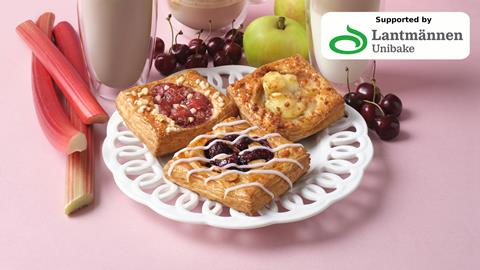

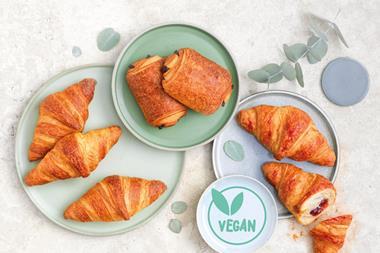

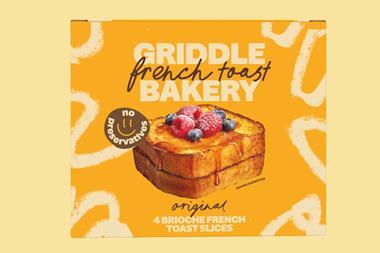

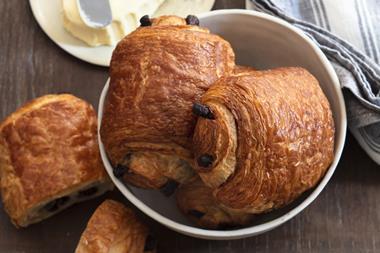


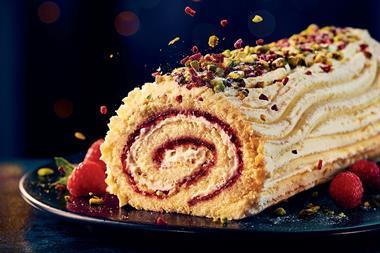

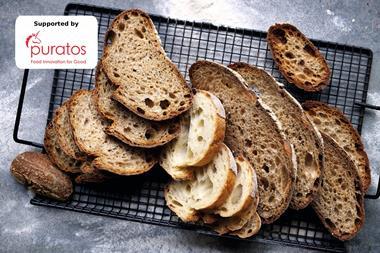


No comments yet